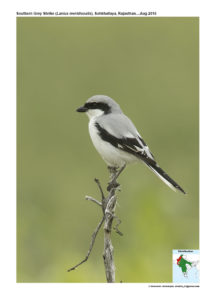Southern Grey Shrike

Southern Grey Shrike Lanius meridionalis
Etymology:
- Lanius : Latin word for Butcher . They are known as ‘butcher-birds,’ from their habit of storing prey by impaling it on thorns and sharp twigs, giving the resemblance to a butcher’s slaughterhouse
- Meridionalis : Latin word for south, southern derived from meridies-south
Distribution inIndia:Widespread resident in North, North West and Western parts of India.
Description: Size of 22-24 cm.It is large shrike with fairly long tail. Male nominate race has black facial mask from lores narrowly through eye back to rear ear-coverts, narrow but distinct and conspicuous white Supercilium often extending anteriorly over bill base; crown to upperparts dark Plumbeous grey, becoming somewhat paler on rump and uppertail-coverts, some white in scapulars; upperwing black, small white patch at base of primaries, tertials tipped white, secondaries narrowly tipped white; tail black, throat white, underparts pale pinkish-grey, undertail-coverts white; iris brown or dark brown; bill and legs black. Female is very like male but slightly duller, may have on average less white in plumage.The juvenile is paler grey above than adult, but has underparts similarly pale buffish pink, occasionally a hint of very faint dark longitudinal stripes below, mask dark brown, lores partly pale
Habitat: It is found in fairly open country dotted with thorny bushes in dry and warm, sunny lowlands to 1200m
Food Habits: It is an opportunistic feeder. It eats a wide variety of insects e.g. grasshoppers and crickets and beetles. Also eats vertebrates such as small mammals, lizards, frogs. Utilizes variety of lookouts, such as bushes, barbed wire, fences and rocks; dives down to take prey on ground. Frequently impales prey items on thorns or barbed wire.
Breeding Habits: They breed in April-May. They are Monogamous. The nest is built by both sexes. It is an untidy deep cup made from dry material such as twigs, grass, wool and similar, often incorporating green plants ,placed on branch or in fork or outer twigs of tree or bush, generally a thorny bush or prickly. They lay a clutch of 2–7 eggs laid one daily, frequent replacements if previous clutch lost. Incubation is done by female, fed on and off nest by male for a period 14–18 days. The chicks are brooded by female, fed usually by both sexes, nestling period 16–19 days. The chicks become independent in 34–40 days after fledging. And ready to breed by end of 1 year. They lay two broods per season